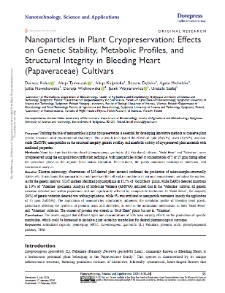Digital Repository of UTP in Bydgoszcz contains 5 069 digital objects
Object
Title: Nanoparticles in plant cryopreservation : effects on genetic stability, metabolic profiles, and structural integrity in Bleeding Heart (Papaveraceae) cultivars
Creator:
Kulus, Dariusz ; Tymoszuk, Alicja ; Kulpińska, Alicja ; Dębska, Bożena (agrotechnika) ; Michalska, Agata ; Nowakowska, Julita ; Wichrowska, Dorota (agronomia) ; Wojnarowicz, Jacek ; Szałaj, Urszula
Date:
Resource Type:
Description:
Publisher:
Dovepress Taylor and Francis Group
Resource Identifier:
doi:10.2147/NSA.S485428 ; oai:dlibra.pbs.edu.pl:5121
Source:
Nanotechnology, Science and Applications 2025:18 35–56
Language:
Relation:
Wydział Rolnictwa i Biotechnologii
License:
Access Rights:
Dla wszystkich zgodnie z powyższą licencją ; click here to follow the link
Object collections:
- Digital Repository PBS > Articles of journals
- Digital Repository PBS > Articles of journals > Natural sciences
- Digital Repository PBS > Faculty PBS > Faculty of Agriculture and Biotechnology
Last modified:
Feb 18, 2025
In our library since:
Feb 18, 2025
Number of object content hits:
34
All available object's versions:
https://dlibra.pbs.edu.pl/publication/5187
Show description in RDF format:
Show description in OAI-PMH format:
Objects Similar
Kulus, Dariusz Tymoszuk, Alicja Kulpińska, Alicja Wojnarowicz, Jacek Szałaj, Urszula
Kulus, Dariusz Tymoszuk, Alicja Kulpińska, Alicja Viehmannova, Iva Wojnarowicz, Jacek Szałaj, Urszula
Kulus, Dariusz
Kulus, Dariusz
Ścigalski, Franciszek Jędrzejewska, Beata Pietrzak, Marek Wiśniewski, Waldemar Pączkowski, Jerzy
Tymoszuk, Alicja Kulus, Dariusz
Dębska, Bożena (agrotechnika)
Wiśniewski, Waldemar Nikczyński, Grzegorz Ścigalski, Franciszek

